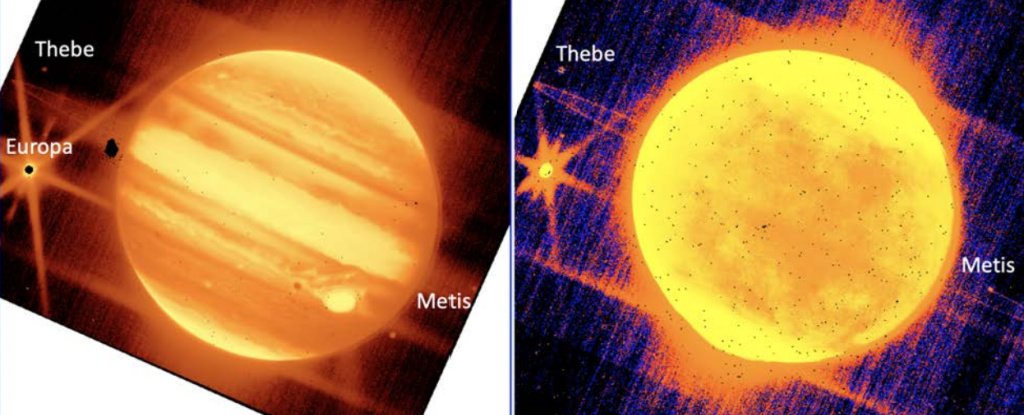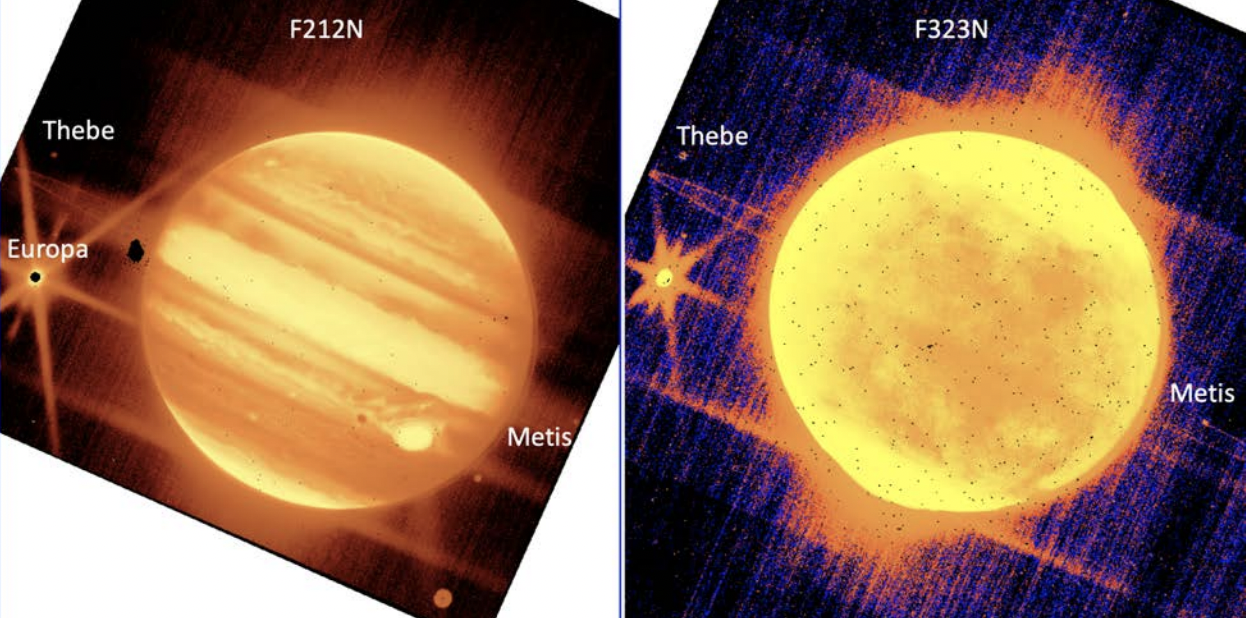
Posted on 07/13/2022 9:00:43 AM PDT by Red Badger

(NASA, ESA, CSA, and STScI)
This morning we were in a frenzy over a sneaky side-glimpse of a galaxy revealed in the first full-color James Webb Space Telescope (JWST) images.
But if you thought that was wild, then wait for this: it turns out JWST has also dropped some stealthy images of Jupiter! And they're ridiculously beautiful.
These images, taken while JWST was being tested, were provided in the JWST commissioning report.
umm who else saw this in the commissioning report document?? 😍😍😍😍🤯🤯🤯🤯🤯https://t.co/AzwQCf6rat pic.twitter.com/nq13fxdsAM
— Erin M. May, PhD (@_astronomay) July 12, 2022 The images, which you can see in greater detail below, show Jupiter and its rings as well as three of its moons: Europa, Thebe, and Metis.
You can also see the shadow of Europa in the image on the left, just next to the planet's tumultuous and infamous Great Red Spot.

Screen Shot 2022 07 13 at 11.58.42 am (NASA, ESA, CSA, and STScI)
Above: The image on the left was taken by the JWST Near-Infrared Camera using a filter that highlights short wavelengths. The image on the right is taken with a filter that highlights long wavelengths of light.
The images were taken by JWST's Near-Infrared Camera (NIRCam) and they use two different filters which highlight separate wavelengths of light.
Part of the test was ensuring that JWST could track fast-moving objects through the Solar System.
For this, JWST photographed nine targets, and Jupiter was the slowest moving – but, as you can see, one of the most stunning.
The test also showed that it's possible to use JWST to photograph details like moons and rings around a planet as bright as Jupiter.
"Observing a bright planet and its satellites and rings was expected to be challenging, due to scattered light that may affect the science instrument employed, but also the fine guidance sensor must track guide stars near the bright planet," the commissioning report explains.
"These observations verified the expectation that guide star acquisition works successfully as long as Jupiter is at least 140" away from the FGS, consistent with pre-flight modeling."
This is all good news as it means JWST will be useful at tracking things like near-Earth objects and comets.
Overall, the commissioning report shows that JWST is performing even better than expected.
"The key outcome of six months of commissioning is this: JWST is fully capable of achieving the discoveries for which it was built. JWST was envisioned 'to enable fundamental breakthroughs in our understanding of the formation and evolution of galaxies, stars, and planetary systems'," the authors write in the report.
"We now know with certainty that it will."
We're looking forward to more photo drops in the coming weeks and months!

Great book.
I like this older picture much better.

It's the one that "astronomers don't want you to know about."
"Especially for seniors born before 1952!"
Regards,
NASA released an "artist's representation" of Oumuamua, and Big Media being the idiots they are ran with it at the expense of a real, bun not spectacular, photograph.
A Faint Fuzzy Danger ... interesting piece of science fiction.
“Potty talk! Very clever.”
Who knows what a bureaucracy will put forth. Maybe those are pictures of someone’s anus in infra-red.
The writers of that article are an insult to science. Examples:
“Just stealthily dropped a picture of Jupiter”
“And we can’t stop staring”.
Surprised they didn’t say “you can’t un-see that”.
You have to realize that these Webb pics are THERMO-GRAPHS not PHOTO-GRAPHS...............
The image on the right, monkey pox?
Good point ... I think people don’t fully understand that JWST is an infrared instrument, and its images will look very different from Hubble.
OTOH, from DC to gamma rays, it’s all photons. MIRI uses a helium cooled doped-silicon focal plane array, the others all use MCT FPAs. They’re photon counting devices, fundamentally the same as your pocket camera.
One thing I observed yesterday while watching the NASA presentation.
The same guy producing the Jan. 6 hearings must’ve done the big NASA show yesterday, too. It wasn’t a very smooth presentation- stiff speakers, there were two ladies from Canada who they went to for something, but their audio wasn’t working so they cut their feed, and didn’t go back to them, either.
A) I do not trust Wiki for much of anything - certainly not history or any controversial subjects.
B) At the time there were 2 raw images released - one of which was labeled Oumuamua, the other is the one on Wiki mislabeled as Oumuamua.
3) They were both imaged with different star backgrounds and different courses. So different ‘objects’.
Or brown.
When it comes to science threads on this site, I'm always amazed that it seems to attract all those obsessed with assholes.
Different objects, or same object imaged at different times? As the thing moved through the solar system, it would necessarily have different starfields behind it.
Jupiter
It’s a gas gas gas
Poppy Seeds..................
Regrettably, science threads attract the attention of people too damn stupid to understand the science. In order to compensate for their inadequacies, they resort to puerile “jokes”.
Yep...
“You have to realize that these Webb pics are THERMO-GRAPHS not PHOTO-GRAPHS...............”
I know that, but they’re not what one would call “beautiful”.
A couple of thoughts ...
Oumuamua was imaged at different times by different telescopes. Those will all have different backgrounds. I don’t personally recall talk of a second object about that time, but I’m not saying there wasn’t one. I just don’t remember it.
That blasted CGI space-turd annoys me a whole lot more. It adds absolutely NOTHING to the discussion, reduces the credibility of the Astronomy community, and distracts from real imagery. And the internet is absolutely flooded with it.
Disclaimer: Opinions posted on Free Republic are those of the individual posters and do not necessarily represent the opinion of Free Republic or its management. All materials posted herein are protected by copyright law and the exemption for fair use of copyrighted works.